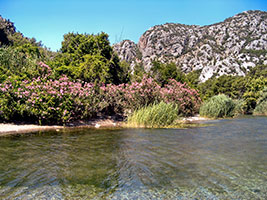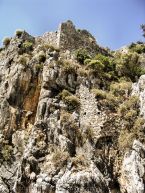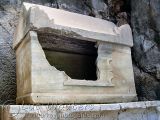Historical Background
Little is known about the early history of Olympos, or Olimpos as it is correctly spelt in Turkish. During the second century BCE, it was an important Lycian city, being one of the six primary members of the Lycian League. Inspired by the nearby eternal flames of the Chimaera, the Olympians worshipped Hephaistos (Vulcan) as their principal deity.
Like nearby Phaselis, Cilician pirates led by Zenicetes overran Olympos and introduced the cult of Mithras. Zenicetes made Olympos his headquarters, but in 78 BCE he was defeated by the Romans. In 43 CE Olympos was absorbed in the Roman Empire and Christianity became the prominent religion. Olimpos remained a trading place under Byzantine, Venetian, and Genoese rule, but by the 15th century, it had been abandoned.
Sights & Photos of Olympos
The first thing to notice about the site is the extensive Byzantine-Genoese fortifications that overlook the beach. A bit further along the beach, the Akdere brook, bordered with flowering oleander and laurel bushes, ends in the sea. Here, the scanty ruins of ancient Olympos overgrown by wild figs and grapevines are scattered on both banks of the Akdere creek.
Next to the beach entrance of Olympos' archaeological site are the harbour memorial tombs that date back to the end of the 2nd century CE and were used for a second time in the 5th century. One burial chamber contains two sarcophagi, of which one can be attributed to an Olympian named Marcus Aurelius Zosimas and the other to his uncle Captain Eudemos. The latter is decorated with a relief of a ship, an inscription that tells of the voyages made by Captian Eudemos and an emotional poem that reads as follows:
The ship sailed into the last harbor and anchored to leave no more,
As there was no longer any hope from the wind or daylight,
After the light carried by the dawn had left Captain Eudemos,
There buried the ship with a life as short as a day, like a broken wave.
Following the Akdere river, there are the ruins of a bathhouse, some remnants of early Christianity and a well-preserved marble door frame.
https://www.turkeyphotoguide.com/olympos?tmpl=component&print=1&page=#sigProId541ac833eb
Travel Information & Travel Tips
It is a fifteen-minute walk along the pebble beach from Çıralı to the historical site of the ancient city of Olympos. About half a day is needed to visit the site that not only offers the historical artefacts but is also of great natural beauty.






















